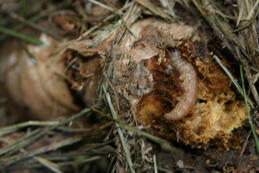
have whitish to pinkish bodies with dark brown heads and are about 2 inches long.
Pupation starts in August and adult moths emerge in September and October. The pupal stage normally lasts two to three weeks with the pupa found about 2 inches deep in the soil. The adults are seldom seen because they are nocturnal. Eggs are laid on brown, dried leaves. Damage by the iris borer is often associated with a disease known as bacterial rot. Wounded rhizomes are easily attacked by this bacterium which results in a foulsmelling decay of the rhizomes.
Removal and burning of dead leaves in the fall will eliminate a number of the iris borer eggs. Larvae can also be killed by hand in June by squeezing infested leaves in the vicinity of the injury. During division, rotted and heavily infested rhizomes should be discarded. Borers in lightly infested rhizomes can be killed by poking them with a piece of wire.
Control can be achieved through the use of products with permethrin (Eight; Hi-Yield Garden & Farm Insect Control) or spinosad (Natural Guard Spinosad, Captain Jack's Deadbug Brew, Monterey Garden Insect Spray). Apply when the shoots are four to six inches long and repeat after 10 to 14 days.
Parasitic nematodes such as Steinernema carpocapsae or Heterorhabditis bacteriophora can also be used. The parasitic nematodes must be applied when the soil temperature is above 50 degrees F. Use one quart water/nematode mix per square foot to allow the nematodes to swim to the pest. Steinernema carpocapsae gave better control (100%) than Heterorhabditis bacteriophora (87%) in research conducted by the University of Maryland. (Ward Upham)
 RSS Feed
RSS Feed
